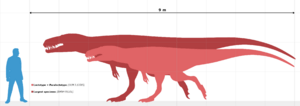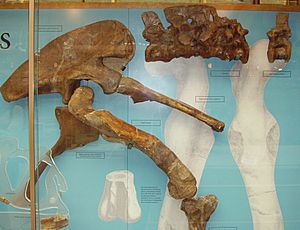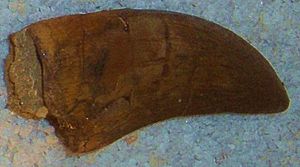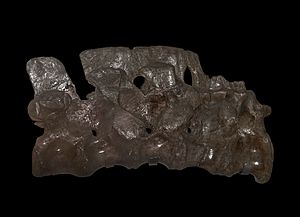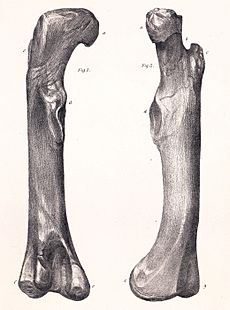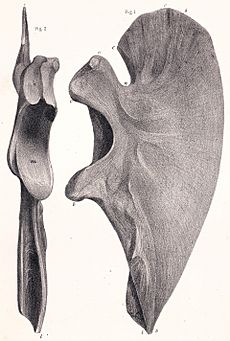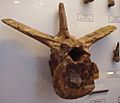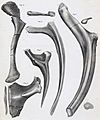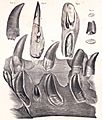Megalosaurus facts for kids
Quick facts for kids MegalosaurusTemporal range: Middle Jurassic
|
|
|---|---|
 |
|
| Fossil specimens referred to M. bucklandii, Oxford University Museum of Natural History. | |
| Scientific classification | |
| Kingdom: | |
| Phylum: | |
| Class: | |
| Superorder: | |
| Order: | |
| Suborder: | |
| Family: | |
| Genus: |
Megalosaurus
Buckland, 1824
|
Megalosaurus was a huge meat-eating dinosaur that lived in Europe during the Middle Jurassic period. Imagine a creature bigger than a school bus, walking on two strong legs. It had a giant head filled with sharp teeth. That's Megalosaurus! This amazing dinosaur lived a very long time ago. It was around between 201 and 145 million years ago. That's millions of years before humans even existed!
The name Megalosaurus means "great lizard." This is a perfect name for such a massive animal. Scientists believe Megalosaurus was a theropod. Theropods were a group of dinosaurs that walked on two legs. Most of them were carnivores, meaning they ate meat. So, Megalosaurus likely spent its days hunting other dinosaurs. It might have also hunted large prehistoric mammals or reptiles.
Contents
Discovering Megalosaurus: A Journey Through Time
The story of Megalosaurus began in 1676. A large bone fragment was found in a quarry in Oxfordshire, England. At that time, people didn't know about dinosaurs. So, the bone was simply called a "giant bone." This was the very first fossil of this dinosaur ever found.
It wasn't until 1824 that Megalosaurus got its official name. William Buckland, a professor at Oxford University, studied the bone fragments. He realized they belonged to a creature unlike anything known before. He named this amazing creature Megalosaurus bucklandii. This was a huge step in understanding ancient life. It also marked the start of paleontology. Paleontology is the study of ancient life, especially fossils.
What Did Megalosaurus Look Like?
When Megalosaurus was first discovered, scientists only had a few bones. This meant they had to guess what the rest of the dinosaur looked like. Because of this, many early drawings of Megalosaurus looked very different from what we think it looked like today.
Even now, we only have parts of Megalosaurus skeletons. Finding a complete dinosaur skeleton is very rare. Scientists use these pieces, along with clues from similar dinosaurs, to figure out how Megalosaurus might have looked.
Megalosaurus had a long, powerful tail. It probably used its tail for balance. This would have helped it turn quickly when hunting. Its head was large and had sharp, jagged teeth. These teeth were curved backward, like hooks. This made it very hard for prey to escape once Megalosaurus had a hold of it.
Its legs were strong and muscular. They could easily support its huge body. Scientists think it had three toes on each foot. These toes ended in sharp claws. The claws helped it grip the ground. They might have also helped it hunt. Its arms were shorter than its legs. It likely used its strong legs much more often.
How Big Was This Giant Dinosaur?
Based on the fossil evidence, Megalosaurus was a very large bipedal dinosaur. Bipedal means it walked on two legs. Scientists estimate it was about 7 to 9 meters (23 to 30 feet) long. It likely weighed between 1 and 2 tons. That's as heavy as a small car!
What Did Megalosaurus Eat?
Megalosaurus was a fierce predator. Its powerful jaws and sharp teeth show that it was a carnivore. This means it ate meat. It probably hunted other dinosaurs. It might have hunted smaller herbivores (plant-eaters) that lived during the Jurassic period.
Life in the Jurassic Period
Megalosaurus lived in a world very different from ours. During the Jurassic period, the climate was much warmer and wetter. Huge forests covered most of the land. Swamps and rivers provided homes for many different plants and animals.
Many other dinosaurs lived alongside Megalosaurus. These included giant plant-eaters like Stegosaurus and Brachiosaurus. Megalosaurus was likely a top predator in its environment. It played an important role in the food chain.
Megalosaurus Today: A Continuing Story
Even though Megalosaurus died out millions of years ago, its fossils are still studied by scientists. These studies help us understand more about prehistoric life. Museums around the world display casts of Megalosaurus skeletons. Visitors can see how big and amazing this creature was. Every new discovery helps scientists learn more about this early giant of the dinosaur world.
Images for kids
-
Lithography from William Buckland's "Notice on the Megalosaurus or great Fossil Lizard of Stonesfield", 1824. Caption reads "anterior extremity of the right lower jaw of the Megalosaurus from Stonesfield near Oxford".
-
1854 reconstruction in Crystal Palace Park guided by Richard Owen presents Megalosaurus as a quadruped; modern reconstructions make it bipedal, like most theropods
See also
 In Spanish: Megalosaurus bucklandii para niños
In Spanish: Megalosaurus bucklandii para niños


